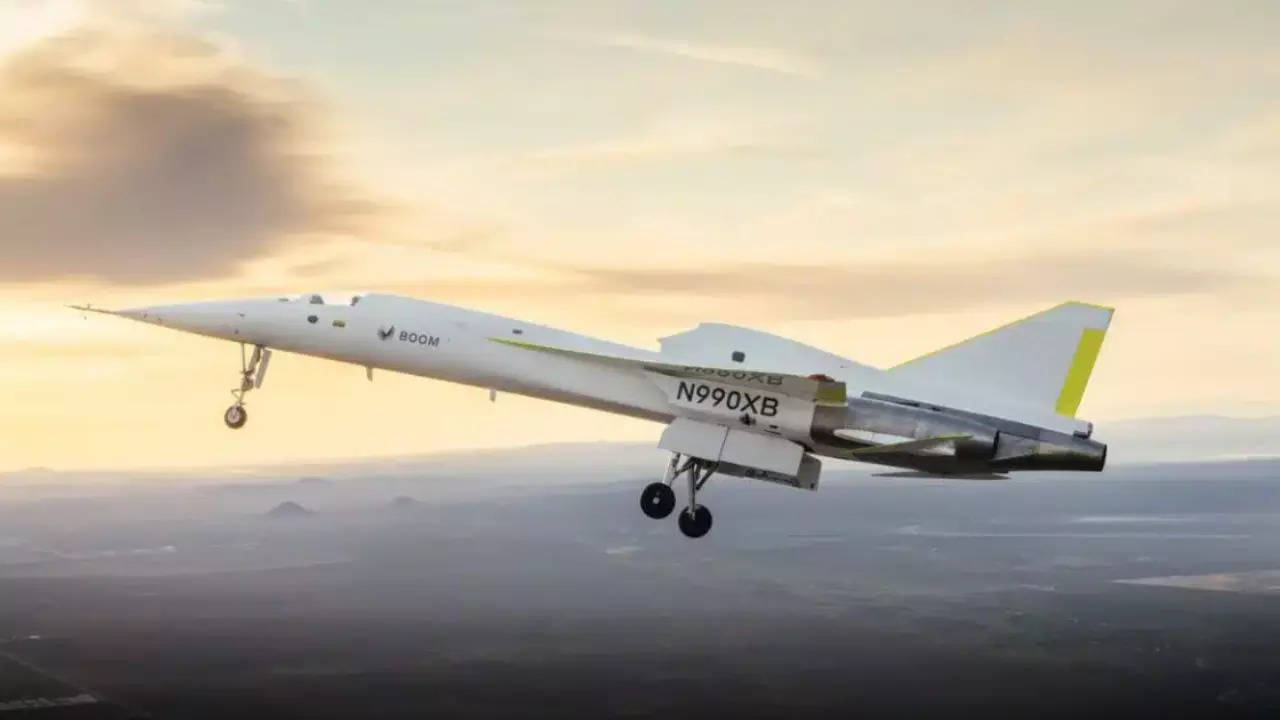World
New York to London in 3.5 hours? This supersonic jet may redefine fast travel

[ad_1]
NEW DELHI: In a groundbreaking advancement for aviation, a demonstrator aircraft, heralding what might be the first civil supersonic plane since the 1960s, successfully soared through its first test flight earlier this month. This event marks a pivotal milestone in the eagerly awaited resurgence of supersonic travel.
The aircraft, named XB-1, was developed by Colorado-based Boom Supersonic and completed its initial test flight at California’s Mojave Air & Space Port, announced on March 22.The XB-1 is celebrated as the world’s first independently developed supersonic jet and serves as a precursor to Boom’s Overture, the commercial plane in development, a CNN report said.
Blake Scholl, CEO of Boom Supersonic, shared his vision with CNN Travel, saying, “I very much believe in the return of supersonic air travel, and ultimately to bring it to every passenger on every route. And that’s not something that takes place overnight.” He emphasized the challenges of designing a sleek and efficient supersonic jet capable of safe takeoff and landing.
During its debut flight, the XB-1 achieved all its test objectives, reaching an altitude of 7,120 feet (2,170 meters) and speeds up to 238 knots (273 miles per hour), which is below the typical altitudes of commercial airliners but a significant step towards achieving supersonic speeds.
Scholl revealed plans for a series of flights over the next five to seven months aimed at breaking the sound barrier, an achievement that has been elusive since the era of the Soviet Tupolev Tu-144 and the British-French Concorde, which last flew in October 2003.
The aviation industry is currently buzzing with supersonic and hypersonic projects, such as Nasa and Lockheed Martin’s “quiet” X-59 aircraft and Atlanta-based Hermeus, which recently unveiled its first flyable aircraft. Scholl attributes the revival of supersonic flight to advancements in digital engineering, aerodynamics, materials, and propulsion.
The XB-1, constructed primarily from carbon fiber composites, employs an innovative augmented reality vision system for landing, eliminating the need for a movable nose, which was a notable feature of the Concorde.
With the aviation industry aiming for net-zero carbon emissions by 2050, Boom’s Overture is designed to run on up to 100% sustainable aviation fuel (SAF), addressing the current challenges of SAF’s availability and cost. Scholl is optimistic about SAF becoming the future of aviation, emphasizing the importance of balancing speed and sustainability.
Scholl’s vision extends beyond immediate advancements, aiming for a future where supersonic flights are more affordable, efficient, and accessible, aligning with his dream of enabling people to “fly anywhere in the world in four hours for $100.” Boom Supersonic aims to carry its first passengers on Overture, boasting speeds of Mach 1.7, before the end of the decade, with an impressive order book from notable airlines.
As Boom Supersonic prepares to open its super-factory in Greensboro, North Carolina, later this year, Scholl anticipates 2024 as a pivotal year for supersonic flight, envisioning a future where supersonic planes replace conventional jets, making air travel faster, more sustainable, and widely accessible, the CNN report said.
The aircraft, named XB-1, was developed by Colorado-based Boom Supersonic and completed its initial test flight at California’s Mojave Air & Space Port, announced on March 22.The XB-1 is celebrated as the world’s first independently developed supersonic jet and serves as a precursor to Boom’s Overture, the commercial plane in development, a CNN report said.
Blake Scholl, CEO of Boom Supersonic, shared his vision with CNN Travel, saying, “I very much believe in the return of supersonic air travel, and ultimately to bring it to every passenger on every route. And that’s not something that takes place overnight.” He emphasized the challenges of designing a sleek and efficient supersonic jet capable of safe takeoff and landing.
During its debut flight, the XB-1 achieved all its test objectives, reaching an altitude of 7,120 feet (2,170 meters) and speeds up to 238 knots (273 miles per hour), which is below the typical altitudes of commercial airliners but a significant step towards achieving supersonic speeds.
Scholl revealed plans for a series of flights over the next five to seven months aimed at breaking the sound barrier, an achievement that has been elusive since the era of the Soviet Tupolev Tu-144 and the British-French Concorde, which last flew in October 2003.
The aviation industry is currently buzzing with supersonic and hypersonic projects, such as Nasa and Lockheed Martin’s “quiet” X-59 aircraft and Atlanta-based Hermeus, which recently unveiled its first flyable aircraft. Scholl attributes the revival of supersonic flight to advancements in digital engineering, aerodynamics, materials, and propulsion.
The XB-1, constructed primarily from carbon fiber composites, employs an innovative augmented reality vision system for landing, eliminating the need for a movable nose, which was a notable feature of the Concorde.
With the aviation industry aiming for net-zero carbon emissions by 2050, Boom’s Overture is designed to run on up to 100% sustainable aviation fuel (SAF), addressing the current challenges of SAF’s availability and cost. Scholl is optimistic about SAF becoming the future of aviation, emphasizing the importance of balancing speed and sustainability.
Scholl’s vision extends beyond immediate advancements, aiming for a future where supersonic flights are more affordable, efficient, and accessible, aligning with his dream of enabling people to “fly anywhere in the world in four hours for $100.” Boom Supersonic aims to carry its first passengers on Overture, boasting speeds of Mach 1.7, before the end of the decade, with an impressive order book from notable airlines.
As Boom Supersonic prepares to open its super-factory in Greensboro, North Carolina, later this year, Scholl anticipates 2024 as a pivotal year for supersonic flight, envisioning a future where supersonic planes replace conventional jets, making air travel faster, more sustainable, and widely accessible, the CNN report said.
#York #London #hours #supersonic #jet #redefine #fast #travel






